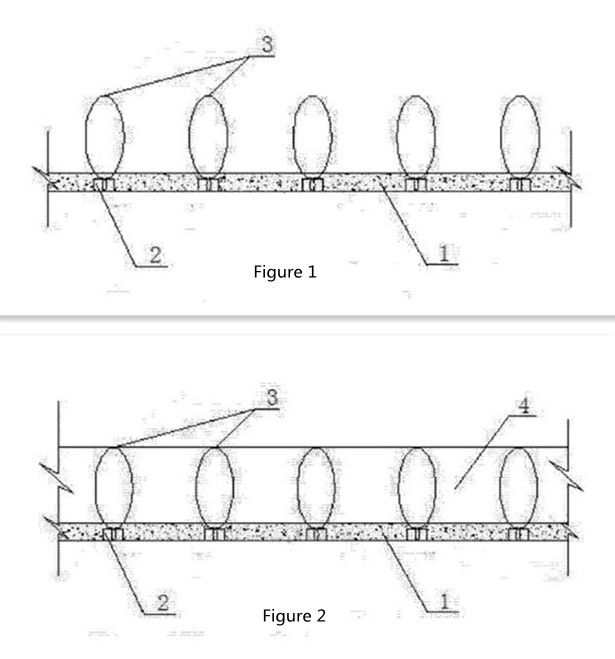Pre-embedded wire fixing HDPE pipe construction method provides a method for fixing HDPE pipe with embedded iron wire. Machine bricks are pre-embedded and a sufficient length of iron wire is tied up before the concrete capsulation of municipal drainage pipes and during the construction of concrete flat foundations. After the HDPE pipes are laid , Use pre-embedded iron wires to bind and fasten HDPE pipes. The specific construction steps are as follows: measuring and lofting → trench excavation → embedding machine brick tying iron wire, concrete flat foundation pouring → pipe laying → tightness inspection → iron wire tying HDPE Pipe → concrete guarantee.
This construction method embeds the iron wire during the pouring of the flat foundation of the municipal flexible drainage pipe. After the pipe is in place, the embedded iron wire is used to fix it to ensure construction accuracy, prevent the flexible pipe from being displaced during the concrete pouring process, and prevent the displacement of the pipe The phenomenon of rework; the construction method has the characteristics of strong safety, stability and reliability, convenient and fast construction, and relatively economical. It effectively guarantees the quality of pipeline installation and ensures the survival of pipeline installation and concrete guarantee at one time.

Construction method of fixing HDPE pipe with pre-embedded iron wire
Technical Field
The construction method of pre-embedded iron wire fixing HDPE pipe relates to a construction method of urban construction engineering, specifically a construction method of pre-embedded iron wire fixing HDPE pipe of flexible pipe material of municipal drainage pipeline.
Background Technique
According to the previous completed projects, HDPE pipeline concrete guarantee pipe, according to the traditional construction technology, the pipeline floating phenomenon is very easy to occur during concrete pouring, which needs to be reworked. At the same time, it causes waste of people, materials, and machinery and increases construction costs. The construction method of using pre-embedded iron wires to fix HDPE pipes mainly solves the problem that the pipes are prone to float up during the concrete pouring of HDPE pipes, which greatly reduces the repair work and the great waste of personnel, materials and machines in the construction process. Simple, the effect is obvious.
Realize The Technical Solution
A construction method for fixing HDPE pipes with pre-embedded iron wires, which is characterized in that the machine bricks are pre-embedded and a sufficient length of iron wire is bound before the concrete capping of the municipal drainage pipeline and during the construction of the concrete flat foundation. Wire the HDPE pipe to be fastened and fastened to ensure that the HDPE pipe does not move when the concrete is covered. The specific construction steps are as follows: measuring and lofting-trench excavation-embedding machine brick tying iron wire, concrete flat foundation pouring-pipeline laying-airtightness inspection One iron wire is used to bind the HDPE pipe and one concrete guarantee pipe. The distance between the iron wires is 1m.
Beneficial Effects
- The iron wire is embedded in the flat foundation of the municipal flexible drainage pipe, and the embedded iron wire is used to fix the pipeline after it is in place to ensure the construction accuracy.
- Prevent displacement of flexible pipes during concrete pouring.
- It can effectively avoid the problems of pipeline floating and plane displacement during concrete pouring.
- Eliminate rework due to pipe displacement.
- Strong operability, simple operation, low technical difficulty, easy control of pipeline installation quality, and improved construction efficiency.
- The qualified rate of one-time installation of the pipeline is high, which reduces the rework phenomenon of pipeline installation, thereby saving the expenditure of mechanical equipment and labor costs.
- Compared with the existing technology, this construction technology has the advantages of strong safety, stability and reliability, convenient and quick construction, and relatively economical characteristics. It effectively guarantees the quality of pipeline installation and ensures the survival of pipeline installation and concrete guarantee.
- Using this method of construction, the trench exposure time is shortened, dust emission is reduced, and the impact on traffic and the environment is reduced, which is conducive to civilized construction.
- With the widespread application of HDPE pipes, this method will be better implemented and better social benefits will be obtained.
- The construction method should be applied in urban flexible drainage pipeline engineering.
Description of the Drawings

Figure 1 is a schematic diagram of flat-base pouring and embedded brick tying wire. Figure 2 is a schematic diagram of pipeline installation and binding and fastening structure.
1 — concrete flat base
2 — pre-embedded brick
3 — Iron wire
4 — HDPE pipe
The Concrete Implementation Method
This method will be described in detail below with reference to the above figure. During the construction of the concrete flat foundation, the machine bricks are pre-embedded and the iron wire of sufficient length is bound. The distance between the iron wires is lm. After the HDPE pipe is laid, the pre-embedded iron wire is used to bind and fasten the HDPE pipe to ensure that the HDPE pipe is covered by the concrete. The tube does not move in any direction.
The specific construction steps are as follows: measuring and lofting, trench excavation, embedding machine brick binding iron wire, concrete flat foundation pouring, pipeline laying, airtightness inspection, iron wire binding HDPE pipe-concrete cladding pipe.
Its technical indicators: "Code for Construction and Acceptance of Water Supply and Drainage Pipeline Engineering" GB50268-2008, page 66, allowable deviation of pipe laying, horizontal axis 15mm, pipe bottom elevation ±10mm.